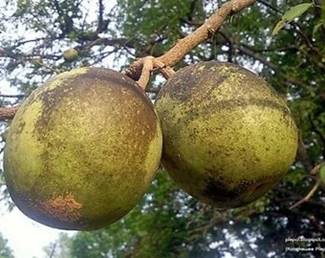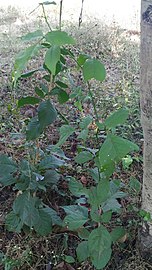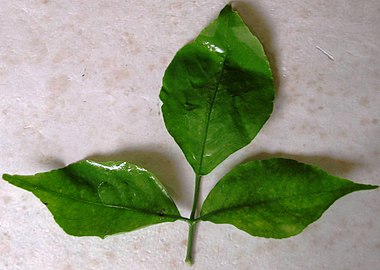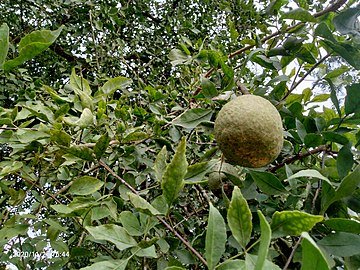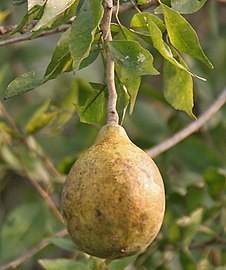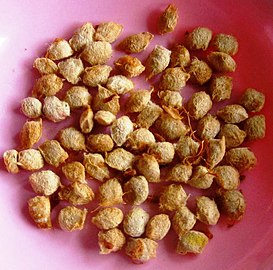-
AEGLE MARMELOS (BAEL)
AEGLE MARMELOS (BAEL)
Couldn't load pickup availability
MINIMUM TEMPERATURE SUPPORTED +3°C
(DATA REFERS TO AN ADULT PLANT IN OPTIMAL HUMIDITY AND SOIL CONDITIONS)
FROM WIKIPEDIA
Aegle marmelos , commonly known as bael (or bili [4] or bhel [5] ), also Bengal quince , [2] golden apple , [2] Japanese bitter orange , [6] hazel apple [7] [8] or wood apple , [6] is a species of tree native to the Indian subcontinent and Southeast Asia . [2] It is present in India , Pakistan , Bangladesh , [9] Sri Lanka and Nepal as a naturalized species . [2] [9] The tree is considered sacred by Hindus and Buddhists .
Description
Aegle marmelos is a small to medium sized deciduous shrub or tree, up to 13 meters (43 feet) tall with slender drooping branches and a rather open, irregular crown. [10]
Bark
The bark is light brown or greyish, smooth or finely fissured and flaking, armed with long straight spines, 1.2–2.5 centimeters ( 1 ⁄ –1 in) singly or in pairs, often with slimy sap exuding from the cut parts . Gum is also described as a clear, rubbery sap, similar to gum arabic, which oozes from injured branches and hangs in long filaments, gradually becoming solid. It's sweet at first and then irritates the throat. [8]
Leaves
The leaf is trifoliate, alternate, each leaflet is 5–14 cm ( 2–5 + 1 ⁄ 2 inches) long x 2–6 cm ( 3 ⁄ 4 – 2 + 1 ⁄ in), ovate with tapered or pointed tip and rounded base, not toothed or with shallow, rounded teeth . The young leaves are light green or pink in color, finely hairy while the mature ones are dark green and completely smooth. Each leaf has 4-12 pairs of lateral veins joined at the margin.
Flowers
The flowers are 1.5 to 2 cm long, light green or yellowish, sweetly scented, bisexual, in short, unbranched hanging clusters at the ends of the twigs and in the axils of the leaves. They usually appear with young leaves. The calyx is flat with 4(5) small teeth. The four or five 6–8 millimeter ( 1 ⁄4–3 ⁄8 in ) petals overlap on the bud. Many stamens have short filaments and short-styled, light brown anthers. The ovary is bright green with an inconspicuous disk.
Fruit
The fruit is typically 5 to 10 cm (2 to 4 in) in diameter. [11] It has a globular or slightly pyriform shape, with a thick and hard rind, which does not split during maturation. The woody shell is smooth and green in color, gray until fully ripe when it turns yellow. Inside there are 8 to 15 or 20 sections filled with aromatic orange pulp, each section with 6 (8) to 10 (15) flattened-oblong seeds each about 1 cm long, bearing woolly hairs and each enclosed in a bag of adhesive and transparent mucilage that solidifies during drying. The exact number of seeds varies in different publications. The fruit takes about 11 months to ripen on the tree, reaching maturity in December. [11] It can reach the size of a large grapefruit or pomelo , and some are even larger. The shell is so hard that it must be broken with a hammer or machete . The yellow fibrous pulp is very aromatic. It has been described as tasting like jam and smelling like roses. Boning (2006) indicates that the flavor is "sweet, aromatic and pleasant, although spicy and slightly astringent in some varieties. It resembles a jam made, partly, with citrus fruits and, partly, with tamarind". [12] Numerous hairy seeds are encapsulated in a slimy mucilage .
Chemistry [ edit ]
The bael tree contains furocoumarins , including xanthotoxol and alloimperatorin methyl ester, as well as flavonoids , rutin , and marmesin ; a series of essential oils; and, among its alkaloids, á -fargarin(= allocryptopine ), O -isopentenylhalfordinol, O -methylhafordinol. [13] Aegeline (N-[2-hydroxy-2(4-methoxyphenyl)ethyl]-3-phenyl-2-propenamide) is a constituent that can be extracted from bael leaves. [14] [15]
Eglemarmelosin, molecular formula C 16 H 15 NO 2 [α] 27 D +7.89° ( c 0.20, CHCl 3 ), was isolated as an orange viscous oil. [16]
Taxonomy
Bael is the only member of the monotypic genus Aegle . [9]
Habit and habitat

Aegle marmelos is native to the Indian subcontinent and Southeast Asia and is cultivated throughout Sri Lanka , Tamilnadu , Thailand, and Malaysia . [2] It occurs in dry, open forests on hills and plains at elevations ranging from 0 to 1,200 m (0-3,937 ft) with average annual precipitation of 570-2,000 mm (22-79 in). [8] [9] In India it has a reputation for being able to grow in places where other trees cannot. It handles a wide range of soil conditions ( pH range 5–10), tolerates waterlogging, and has an unusually wide temperature tolerance from −7–48 °C (19–118 °F). [9] Requires a pronounced dry season to bear fruit.
Ecology
The tree is a larval food plant for the following two Indian swallowtail butterflies : the linden butterfly ( Papilio demoleus ) and the common Mormon butterfly ( Papilio polytes ).
Toxicity
Aegeline is a well-known constituent of bael leaf and is consumed as a dietary supplement with the intent of producing weight loss. [14] [15] In 2013, the Food and Drug Administration (FDA), the Centers for Disease Control and Prevention (CDC), the Department of Defense Armed Forces Health Surveillance Center, and state and local health officials of Hawaii identified an outbreak of 97 people with acute nonviral hepatitis that first emerged in Hawaii. Seventy-two of these people had reported using the aegeline-containing dietary supplement , called OxyElite Pro, made by the Dallas company , USPlabs. [14] [17] The FDA had previously taken action against an earlier formulation of OxyElite Pro because it contained dimethylamylamine , a stimulant that the FDA had determined was an adulterant when included in dietary supplements and which could cause hypertension and lead to seizures heart, seizures, psychiatric disorders and death. [17] USPlabs subsequently reformulated this product without notifying the FDA or submitting the safety data required for a new dietary ingredient. [17]
Doctors at the Liver Center at Queen's Medical Center investigating the first cases in Hawaii reported that between May and September 2013, eight previously healthy individuals presented to their center suffering from drug-induced liver damage. [14] [18] All of these patients had used reformulated OxyElite Pro, which they purchased from different sources and which had different lot numbers and expiration dates, at doses within the manufacturer's recommendations. [14] [18] Three of these patients developed fulminant liver failure, two underwent urgent liver transplantation, and one died. [14] [18] The number of such cases would eventually rise to 44 in Hawaii. [14] [18] In January 2014, leaders of the Queen's Liver Center informed state legislators that they were almost certain that hegelin was the causative agent in these cases, [19] but the mechanism by which hegelin can damaging the liver has not been clarified. isolated. [14]
Uses
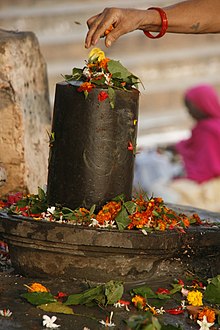
Culinary
Rich in vitamin C , [11] the fruits can be consumed fresh from the trees or after being dried [20] and made into candy, toffee , powdered pulp, or nectar . [9] If fresh, the juice is filtered and sweetened to obtain a lemonade- like drink . [11] It can be made into sharbat , also called Bela pana , a drink. Bela Pana made in Odisha contains fresh cheese, milk, water, fruit pulp, sugar, crushed black pepper and ice. Bæl pana , a drink made from the pulp, is mixed with water, sugar and citron juice , left to rest for a few hours, filtered and placed on ice. One large bael fruit can yield five or six liters of sharbat. If the fruit is to be dried, it is usually sliced and dried in the sun. The hard, leathery slices are then immersed in water. The leaves and small shoots are eaten as a salad . Bael fruits are of dietary use and the pulp of the fruit is used to prepare delicacies such as murabba , puddings and juices.
Traditional medicine
The leaves, bark, roots, fruits and seeds are used in traditional medicine to treat various diseases, [9] although there is no clinical evidence that these methods are safe or effective. [ citation needed ]
In culture
Bael is considered one of the sacred trees of the Hindus [21] (known in Sanskrit as बिल्व bilva [22] ) so it is used in ritual rites. [23] [24] The first evidence of the bael's religious importance appears in the Sri Sukta of the Rigveda , which venerates this plant as the residence of the goddess Lakshmi , the deity of wealth and prosperity. [25] Bael trees are also considered an incarnation of the goddess Sati . [26] Bael trees can usually be seen near Hindu temples and their home gardens. Shiva is believed to love bael trees so much that he earned the epithet बिल्वदण्ड Bilvadaṇḍa or "beautiful- stick ". [22] His leaves and fruits still play a major role in his cult, because the triple shape of the leaf symbolizes his trident . [28]
In traditional practice of the Hindu and Buddhist religions by people of the Newar culture of Nepal , the bael tree is part of a fertility ritual for girls known as Bel Bibaaha . The girls are "married" to the bael fruit; as long as the fruit is kept safe and never breaks, the girl can never become a widow, even if her human husband dies. This is a ritual that ensures the high status of widows in the Newar community compared to other women in Nepal. [29]
RICHIEDI FOTO
RICHIEDI FOTO
Scrivimi su WhatsApp al +393472475878 per ricevere foto piante in vendita
